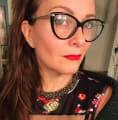6 tips for creating shelf decor that is pretty and practical
Make sure your "shelfie" is on point.
Products are chosen independently by our editors. Purchases made through our links may earn us a commission.
In the past, you would only venture guesses at how co-workers and co-eds set up their homes. Their bookshelves, desks, (gasp) bedrooms were all a design mystery—is by-the-book Susan from accounting a closet animal print fiend? Does the dining room of your daughter’s class president rival a design magazine spread?
Thanks to Zoom meetings, we’re all peeking into rooms we normally wouldn’t have access to. So that backdrop wall had better be gorgeous. This here-and-now concern is perhaps the guiding force behind the trend of “shelfies” for 2021.
Whether you're in the kitchen, living room, or bedroom-turned-home office, using plants, books, or knick-knacks can create picture-perfect arrangements for when you (and your home) are on display.
Shelfies are trending
“Updating your shelves is an easy way to freshen up a room and add interest to an overlooked area. Most shelves look great with groupings of two or three items. It's all about balancing out the shelves,” says Francesca Weber, co-owner of Arrow Design, a boutique decorating firm based in coastal New Jersey.
“Pinterest is a great source to get ideas,” she adds, supporting the fact that Pinterest has “shelfie” on its list of 2021 trend predictions based on the term’s search numbers.
Work with what you have or pick out new accessories from an affordable store like Target or Home Goods for simple updates. For more inspiration, check out these other tips.
Lose the symmetry
While symmetry may be popular in interior design, asymmetry is your best friend when you’re creating vignettes that showcase your collections, according to interior designer Courtney Sempliner. More visually interesting than its predictable counterpart of balanced groupings, this visual technique instead has one large item on one side, several small focal points on the other.
“To nail this asymmetrical look, start styling the left side of your shelf with a stack of books topped with a decorative object for height. To the right of the stack, accent the shelf with a photo frame, and voila.”
A good rule of thumb: If your chaos appears controlled, you’ll avoid a cluttered result.
Group items by a common denominator
Think “color, texture, or material, whether it be monochromatic books or a collection of ceramics,” continues Sempliner. If getting bold with your wall color isn’t your thing, instead choose a shelf décor that centers on one pop of color in varying textured items.
Translation: This is the perfect place for all of those blue glass bottles you’ve been squirreling away for years.
Stack books vertically and horizontally
This librarian’s nightmare is a designer’s dream. Katie Davis, founder and lead designer at interior design and home organization company Spruce Design, loves to play around with colors and sizes.
“Try making a few color-coded piles or featuring groups of books with fun binding,” she suggests. “Instead of using up an entire shelf with one long row of books, try separating them out into smaller stacks throughout the entire bookcase. This way, you can feature bookends or stack candles or dishes on top.”
Plants, plants, plants!
“Cascading plants make every shelf beautiful,” says Davis. “Plants big and small can bring the variety you might be missing from your shelving—especially in the kitchen. Plants keep our bookcases from becoming just a blur of books and trinkets.”
If you're struggling with how to fill the last few empty spaces on your shelf, add a tiny succulent.
Play with texture, shapes, and height
Creating your "shelfie" is all about showcasing your personality, your style, and your taste. What you put on your shelf is entirely up to you—and it will look great as long as you maintain variety, explains Davis.
“If every item on your shelf is the same height, mix it up. If every grouping is the same shape, mix it up. If everything is wooden…you guessed it…mix it up with a plant or textured pottery,” she says.
Less is more
When in doubt, let your shelves breathe. “I’m a firm believer that basic accents can stand alone as simple statements, if you just let them,” explains Davis. “The more you clutter up a bookcase, the less people notice what's there. Empty space on a shelf is OK.”


